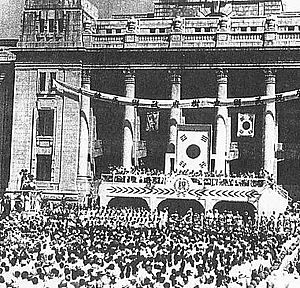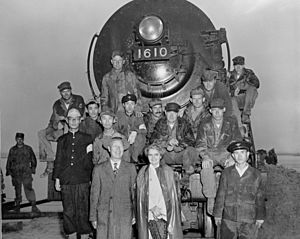Syngman Rhee facts for kids
Quick facts for kids
Syngman Rhee
|
|
|---|---|
| 이승만 李承晩 |
|
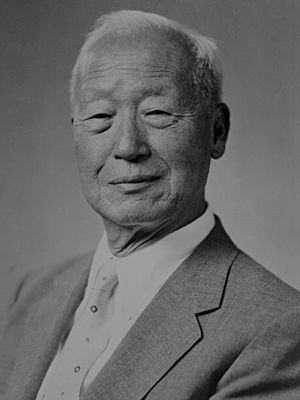
Official portrait, 1948
|
|
| 1st President of South Korea | |
| In office 24 July 1948 – 26 April 1960 |
|
| Prime Minister | Lee Beom-seok Shin Song-mo Chang Myon Yi Yun-yong Chang Taek-sang Baek Du-jin Byeon Yeong-tae |
| Vice President | Yi Si-yeong Kim Seong-su Ham Tae-young Chang Myon |
| Preceded by | Office established |
| Succeeded by | Yun Posun |
| Speaker of the National Assembly | |
| In office 31 May 1948 – 24 July 1948 |
|
| Preceded by | Office established |
| Succeeded by | Shin Ik-hee |
| Chairman of the State Council of the Provisional Government of the Republic of Korea | |
| In office 3 March 1947 – 15 August 1948 |
|
| Deputy | Kim Gu |
| Preceded by | Kim Gu |
| Succeeded by | Office abolished |
| President of the Provisional Government of the Republic of Korea | |
| In office 11 September 1919 – 23 March 1925 |
|
| Prime Minister | Yi Donghwi Yi Dongnyeong Sin Gyu-sik No Baek-rin Park Eunsik |
| Preceded by | Office established |
| Succeeded by | Park Eunsik |
| Personal details | |
| Born |
Rhee Syngman
26 March 1875 Neungnae-dong, Daegyeong-ri, Masan-myeon, Pyeongsan County, Hwanghae, Joseon |
| Died | 19 July 1965 (aged 90) Honolulu, Hawaii, U.S. |
| Resting place | Seoul National Cemetery |
| Nationality | Korean (1875–1910) Stateless (1910–1945) South Korean (1945–1965) |
| Political party | Liberal |
| Spouses |
Seungseon Park
(m. 1890–1910)Franziska Donner
(m. 1934–1965) |
| Alma mater | George Washington University (BA) Harvard University (MA) Princeton University (PhD) |
| Religion | Korean Christianity |
| Signature |  |
| Korean name | |
| Hangul |
이승만 / 리승만
|
| Hanja |
李承晩
|
| Revised Romanization | I Seung(-)man / Ri Seung(-)man |
| McCune–Reischauer | Yi Sŭngman / Ri Sŭngman |
Syngman Rhee (Korean: 이승만, pronounced [i.sɯŋ.man]; 26 March 1875 – 19 July 1965) was a very important South Korean politician. He served as the first president of South Korea from 1948 to 1960.
Rhee also led the Provisional Government of the Republic of Korea at different times. As president, his government was known for being very strict. There was not much economic growth, and later, people started to protest more. Strict rule continued in South Korea even after Rhee left office, until 1987.
Born in Hwanghae Province, Joseon (which is now Korea), Rhee went to an American school. There, he became a Christian. He joined groups that were against Japan's influence after a war in 1895. He was put in prison in 1899. After being released in 1904, he moved to the United States. He earned degrees from American universities and even met President Theodore Roosevelt.
After a short return to Korea, he moved to Hawaii in 1913. He worked for Korean provisional governments and spoke for them to Western countries. In 1945, the U.S. military helped him return to Korea. On 20 July 1948, he was elected the first President of the Republic of Korea.
As president, Rhee was strongly against communism and supported the United States. Early in his time as president, his government stopped a communist uprising on Jeju Island. Many people were killed during events like the Mungyeong Massacre and Bodo League massacre. These events targeted people thought to be communist supporters.
Rhee was president when the Korean War (1950–1953) started. North Korea invaded South Korea. He did not want to sign the agreement that ended the war. He hoped to unite Korea by force.
After the war, South Korea's economy was still weak. It relied a lot on help from the U.S. Rhee was re-elected in 1956. The rules were changed so he could run for president more than twice, even though people protested. He won again in March 1960 without anyone running against him, because his opponent died. But when his friend won the vice-presidential election by a lot, people said the election was unfair. This led to big protests. Students led the April Revolution after police shot demonstrators. This forced Rhee to resign on 26 April. He was secretly flown to Honolulu, Hawaii, where he lived until he died in 1965.
Contents
Early Life and Fight for Independence
Growing Up in Korea
Syngman Rhee was born on 26 March 1875, in a village in Pyeongsan County, Korea. He was the only son in his family to live past infancy. His family had a connection to an old Korean king, Taejong of Joseon.
When Rhee was two, his family moved to Seoul. He had a traditional education, learning about Confucianism. When he was six, he almost lost his eyesight due to smallpox. Luckily, he was treated with Western medicine and got his sight back.
In 1894, Rhee started attending Pai Chai School, an American Methodist school. There, he learned English and new subjects. He also became a Christian. He worked for newspapers, including the first daily newspaper in Korea. He also taught Korean to Americans.
Working for Korean Freedom
After a war in 1895, Japan gained more power over Korea. Rhee became involved in groups that wanted Korea to be independent from Japan. He helped organize protests against corruption and foreign influence.
In 1899, Rhee was put in prison. He was accused of being involved in a plot against the king. While in prison, he wrote books and translated others. One of his famous books was called The Spirit of Independence.
Life Abroad and Political Work
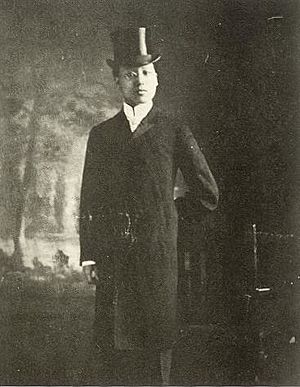
In 1904, Rhee was released from prison. He then moved to the United States. In 1905, he met with U.S. President Theodore Roosevelt. He tried to convince the U.S. to help Korea stay independent, but he was not successful.
Rhee stayed in the U.S. to study. He earned degrees from George Washington University, Harvard University, and Princeton University. He got his PhD in 1910.
He returned to Korea briefly in 1910 but had to leave again in 1912. He moved to Hawaii in 1913. There, he continued to work for Korean independence. He published a magazine and started a Christian church for Koreans.
In 1919, after a big independence movement in Korea, Rhee was chosen for important roles in different Korean provisional governments. He tried to get world leaders to support Korea's independence at peace conferences, but he faced many challenges.
In 1925, Rhee was removed from his position as president of the Provisional Government in Shanghai. This was due to accusations of misusing his power. However, he continued his independence work from the U.S. He tried to raise the issue of Korean independence at the League of Nations in 1933.
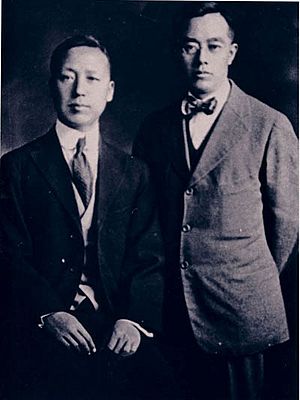
In 1939, Rhee moved to Washington, D.C. He wrote a book called Japan Inside Out. When World War II started, he worked to get the U.S. to recognize the Korean provisional government.
Presidency (1948–1960)
Becoming South Korea's First President
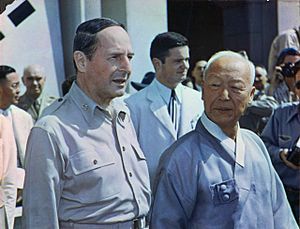
After Japan surrendered in 1945, Rhee returned to Korea. The U.S. military government helped him get back. He quickly became a leading figure in South Korea. He was strongly against communism. He also did not want other countries to control Korea.
Korea had been divided by different groups who wanted independence. Rhee was seen as a good choice for conservative leaders because he had lived in the U.S. and spoke English well. This made him a favorite of the American occupation government.
In 1947, the United Nations General Assembly recognized Korea's independence. In May 1948, elections were held in South Korea. Rhee was elected to the assembly and became its speaker. He helped create the rule that the president would be elected by the National Assembly.
On 20 July 1948, Rhee was elected the first president of the Republic of Korea. He won with a large majority of the votes. On 15 August, South Korea was officially formed, and Rhee became its first president. A month later, North Korea also declared its own government.
Strict Rule and Challenges
Soon after becoming president, Rhee put in place laws that limited people's freedom to disagree with the government. Many people who opposed him were arrested or killed. For example, Kim Gu, another important leader, was assassinated in 1949.
Rhee's government allowed its security forces to arrest and torture people suspected of being communists. His government was also involved in several massacres. This included stopping an uprising on Jeju Island, where many people died. By 1950, many people suspected of being communists were in jail or in a "re-education" program. When the Korean War started, many of these prisoners were killed.
The Korean War Years
Both Rhee and North Korea's leader, Kim Il-sung, wanted to unite Korea under their own rule. However, the U.S. did not give South Korea strong weapons. This was to make sure South Korea's military was only for defense.
On 25 June 1950, North Korean troops invaded South Korea. They quickly moved into Seoul. Rhee and his government left the city. On 28 June, South Korean military forces destroyed the Han Bridge, trapping thousands of people. North Korean soldiers then took over Seoul.
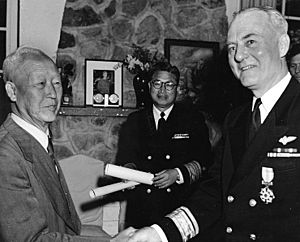
Rhee set up a temporary government in Busan. After a major battle, the North Korean military was pushed back. United Nations forces, including Americans and South Koreans, took back South Korea and moved into North Korea. Rhee wanted to keep fighting to unite all of Korea under his rule. But when China joined the war, UN forces had to retreat.
During the war, Rhee's government was known for corruption. Soldiers sometimes didn't get paid, and supplies were stolen. One major scandal involved the National Defense Corps. Many men in this group died from hunger and cold because money meant for them was stolen.
Rhee was very against the idea of a ceasefire. He wanted to keep fighting until Korea was united. He even released 25,000 prisoners of war in 1953 to try and stop peace talks. This made China and North Korea angry.
On 27 July 1953, the war finally ended with an armistice agreement. This agreement was signed by military commanders from China, North Korea, and the United Nations. Rhee refused to sign it because he still wanted to unite Korea by force. A peace treaty was never signed, so the war technically never ended.
Re-election and Resignation
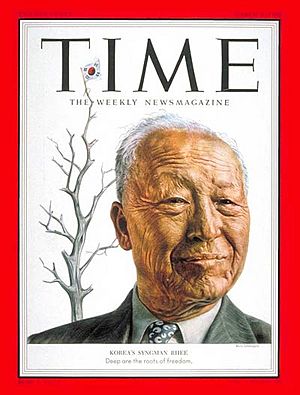
After the war, South Korea was still struggling. Rhee was re-elected in 1956. The constitution had a rule that presidents could only serve two terms. But Rhee had the rules changed so he could run for an unlimited number of terms. This caused many protests.
In March 1960, the 84-year-old Rhee won his fourth term. His main opponent died before the election, so Rhee won easily. However, when his chosen vice-president won by a very large margin, people believed the election was unfair.
This led to widespread anger and protests. On 19 April, police shot demonstrators, which started the student-led April Revolution. These protests forced Rhee to resign on 26 April.
On 28 April, Rhee was secretly flown out of South Korea by the U.S. CIA. He went to Honolulu, Hawaii, with his wife and adopted son. He lived there in exile for the rest of his life.
Personal Life and Death
Rhee was married to Seungseon Park from 1890 to 1910. They divorced after their son died.
In 1933, Rhee met Franziska Donner from Austria. They got married in 1934. She also worked as his secretary.
Rhee adopted three sons over the years. One of them was Lee Kang-seok, who was a distant cousin. After Rhee went into exile, Rhee In-soo was adopted as his heir.
Syngman Rhee died from a stroke on 19 July 1965, at the age of 90. A week later, his body was returned to Seoul. He was buried in the Seoul National Cemetery.
Legacy
Rhee's former home in Seoul, called Ihwajang, is now a museum about him. There is also another memorial museum in Hwajinpo.
Works
- The Spirit of Independence (독립정신,獨立精神,1904)
- Neutrality as influenced by the United States (1912)
- Japan Inside and Out (1941)
See also
 In Spanish: Syngman Rhee para niños
In Spanish: Syngman Rhee para niños
- President of South Korea
- Francesca Donner
- Inha University
- Korean independence movement
- Korean National Association


